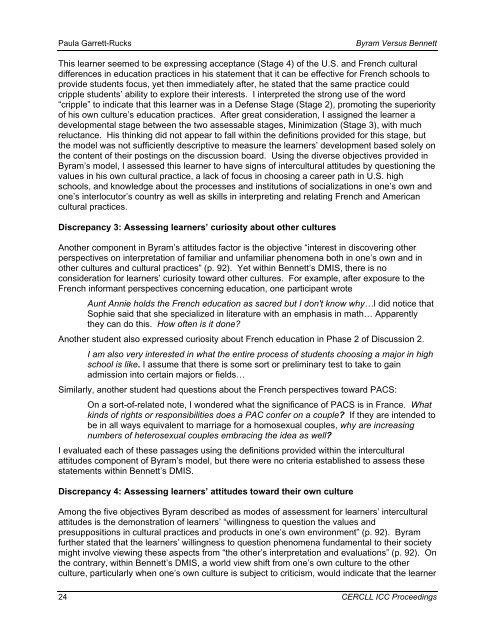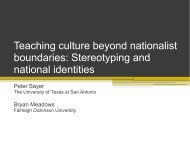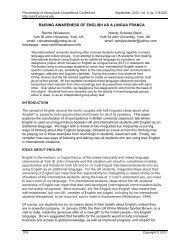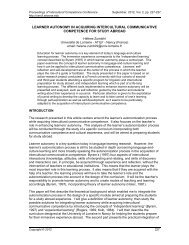BYRAM VERSUS BENNETT: DISCREPANCIES IN THE ... - CERCLL
BYRAM VERSUS BENNETT: DISCREPANCIES IN THE ... - CERCLL
BYRAM VERSUS BENNETT: DISCREPANCIES IN THE ... - CERCLL
You also want an ePaper? Increase the reach of your titles
YUMPU automatically turns print PDFs into web optimized ePapers that Google loves.
Paula Garrett-Rucks Byram Versus Bennett<br />
This learner seemed to be expressing acceptance (Stage 4) of the U.S. and French cultural<br />
differences in education practices in his statement that it can be effective for French schools to<br />
provide students focus, yet then immediately after, he stated that the same practice could<br />
cripple students’ ability to explore their interests. I interpreted the strong use of the word<br />
“cripple” to indicate that this learner was in a Defense Stage (Stage 2), promoting the superiority<br />
of his own culture’s education practices. After great consideration, I assigned the learner a<br />
developmental stage between the two assessable stages, Minimization (Stage 3), with much<br />
reluctance. His thinking did not appear to fall within the definitions provided for this stage, but<br />
the model was not sufficiently descriptive to measure the learners’ development based solely on<br />
the content of their postings on the discussion board. Using the diverse objectives provided in<br />
Byram’s model, I assessed this learner to have signs of intercultural attitudes by questioning the<br />
values in his own cultural practice, a lack of focus in choosing a career path in U.S. high<br />
schools, and knowledge about the processes and institutions of socializations in one’s own and<br />
one’s interlocutor’s country as well as skills in interpreting and relating French and American<br />
cultural practices.<br />
Discrepancy 3: Assessing learners’ curiosity about other cultures<br />
Another component in Byram’s attitudes factor is the objective “interest in discovering other<br />
perspectives on interpretation of familiar and unfamiliar phenomena both in one’s own and in<br />
other cultures and cultural practices” (p. 92). Yet within Bennett’s DMIS, there is no<br />
consideration for learners’ curiosity toward other cultures. For example, after exposure to the<br />
French informant perspectives concerning education, one participant wrote<br />
Aunt Annie holds the French education as sacred but I don't know why…I did notice that<br />
Sophie said that she specialized in literature with an emphasis in math… Apparently<br />
they can do this. How often is it done?<br />
Another student also expressed curiosity about French education in Phase 2 of Discussion 2.<br />
I am also very interested in what the entire process of students choosing a major in high<br />
school is like. I assume that there is some sort or preliminary test to take to gain<br />
admission into certain majors or fields…<br />
Similarly, another student had questions about the French perspectives toward PACS:<br />
On a sort-of-related note, I wondered what the significance of PACS is in France. What<br />
kinds of rights or responsibilities does a PAC confer on a couple? If they are intended to<br />
be in all ways equivalent to marriage for a homosexual couples, why are increasing<br />
numbers of heterosexual couples embracing the idea as well?<br />
I evaluated each of these passages using the definitions provided within the intercultural<br />
attitudes component of Byram’s model, but there were no criteria established to assess these<br />
statements within Bennett’s DMIS.<br />
Discrepancy 4: Assessing learners’ attitudes toward their own culture<br />
Among the five objectives Byram described as modes of assessment for learners’ intercultural<br />
attitudes is the demonstration of learners’ “willingness to question the values and<br />
presuppositions in cultural practices and products in one’s own environment” (p. 92). Byram<br />
further stated that the learners’ willingness to question phenomena fundamental to their society<br />
might involve viewing these aspects from “the other’s interpretation and evaluations” (p. 92). On<br />
the contrary, within Bennett’s DMIS, a world view shift from one’s own culture to the other<br />
culture, particularly when one’s own culture is subject to criticism, would indicate that the learner<br />
24 <strong>CERCLL</strong> ICC Proceedings





